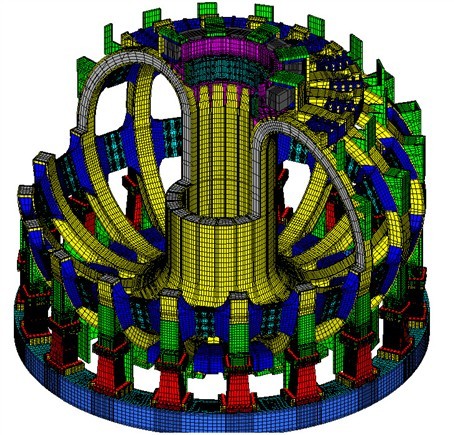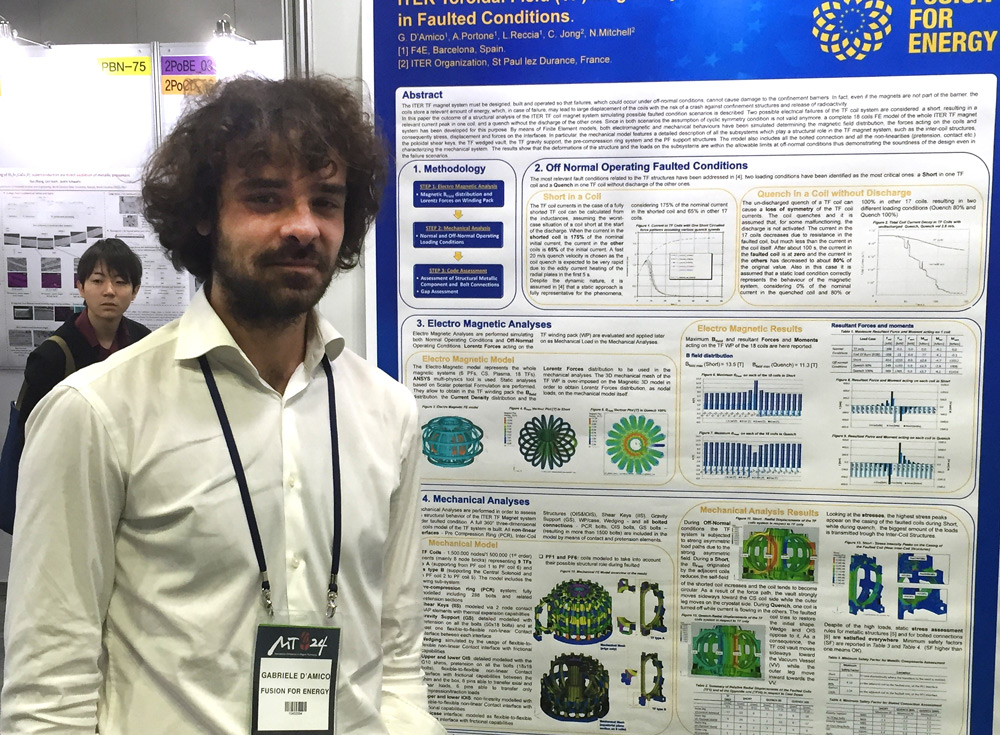F4E develops numerical model representing whole ITER TF coil system


A new numerical model representing the entire ITER Toroidal Field (TF) coil system (18 coils in total) has been developed by F4E. “It’s the first time we have a complete model of the entire ITER TF system with such a level of detail”, says Gabriele D’Amico, F4E Technical Support Officer responsible for the development of this model, “The level of complexity of the tool is outstanding. For example there are more than 1,500 bolts connecting the different pieces of the TF magnet system and the model allows us to predict the behaviour of each one during operations”, he explains.
The magnet system will be a key system in ITER since it will create the magnetic “cage” needed to confine the plasma and to prevent the particles from escaping and thus keeping the plasma “stable”. A very strong magnetic field will be needed (200,000 times higher than the earth’s magnetic field).
The model, which is a coupled electromagnetic-mechanical model, is capable of computing the magnetic fields produced by the set of superconducting coils and the consequent electromagnetic forces acting on the magnet system, which are the result of the interaction between electrical currents and the magnetic field. “It is incredible to see the magnitude of the forces which will act on the magnets” adds Gabriele D’Amico. We are talking about more than 400 MN acting on each TF coil”. Once the magnetic forces acting on the system are calculated, the model is able to simulate how the magnet system will deform during operation when the TF coil system will be cooled at the cryogenic temperature of 4K. “In short, this model will simulate how the TF coil system will function during the operation of the ITER machine”.
The model, which took six months to develop, enables F4E and ITER IO to simulate different scenarios using a completely new approach and avoiding all the simplifications needed in the past. Its main advantage is related to the fact that the whole TF system is modelled, all the 18 coils and all the main subsystems are detailed which allows for a wider understanding and complete overview. F4E developed this numerical model at the request of ITER IO’s Magnet Team in order to understand what would happened if there were to occur an electrical fault during operation. “While the likelihood of this type of problem is low, we have to take into account all possibilities. Thanks to this model we had the opportunity to understand what potential damage would be caused to the TF coils systems and the vacuum vessel, if such a fault were to occur and the model has shown us that the design is sound and there is no risk”, explains Gabriele D’Amico.
The application of this numerical model to the analysis of the ITER Magnet system received a great deal of praise when it was presented to the scientific fusion community during the last Magnet Technology International Conference held in Seoul last October.
The assembly of the TF coil system (each coils weighing 300 tonnes and measuring 16 x 9 metres) at the ITER site, will necessitate an assembly within the tolerances of a few millimetres. Currently the model is being used by F4E, in collaboration with ITER IO’s Magnet team, in order to simulate and study the impact of possible misalignment in the assembly of the coils on the behaviour of the whole system. “The model has shown to be a highly useful tool and we plan to use it further to support the manufacturing of the TF coil system” says Gabriele D’Amico.
